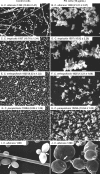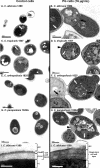Changes in cell wall synthesis and ultrastructure during paradoxical growth effect of caspofungin on four different Candida species
- PMID: 21060107
- PMCID: PMC3019691
- DOI: 10.1128/AAC.00633-10
Changes in cell wall synthesis and ultrastructure during paradoxical growth effect of caspofungin on four different Candida species
Abstract
Paradoxical growth (PG) has been described for echinocandins and is characterized by cell growth at drug concentrations above the MIC. In this study, two isolates each of Candida albicans, C. tropicalis, C. orthopsilosis, and C. parapsilosis, all of which displaying PG in response to caspofungin, were subjected to MIC, minimal fungicidal concentration (MFC), and time-kill curve assays to evaluate the levels of PG. Cell wall components and ultrastructural modifications of the PG cells were also investigated. The results showed that when cell growth and survival were evaluated by MFC or time-kill curve assays, high concentrations of caspofungin did not show fungicidal activity against PG cells. Furthermore, for C. parapsilosis and C. orthopsilosis, time-kill curves were more discriminatory than MFCs in detecting the PG effect. The four different Candida species studied demonstrated similar alterations in cell wall components and ultrastructure associated with PG. In PG cells, β-1,3-glucan content decreased from 2.7- to 7.8-fold, whereas chitin content increased from 4.0- to 6.6-fold. An electron microscopy study of the PG cells revealed morphological alterations, clumping of cells, enlarged cells, the absence of filamentation, abnormal septa, and accumulation of chitin in the cell wall. Also, PG cells basically exhibited a single dark high-density layer in the cell wall, indicating the loss of the β-1,3-glucan layer. Our results present novel details about the ultrastructural alterations that occur in C. albicans, C. parapsilosis, C. orthopsilosis, and C. tropicalis during PG and show that chitin is the major component of the cell walls of PG cells. Stimulation of chitin synthesis may represent a rescue mechanism against caspofungin activity.
Figures





Similar articles
-
Paradoxical growth of Candida albicans in the presence of caspofungin is associated with multiple cell wall rearrangements and decreased virulence.Antimicrob Agents Chemother. 2014;58(2):1071-83. doi: 10.1128/AAC.00946-13. Epub 2013 Dec 2. Antimicrob Agents Chemother. 2014. PMID: 24295973 Free PMC article.
-
Elevated chitin content reduces the susceptibility of Candida species to caspofungin.Antimicrob Agents Chemother. 2013 Jan;57(1):146-54. doi: 10.1128/AAC.01486-12. Epub 2012 Oct 22. Antimicrob Agents Chemother. 2013. PMID: 23089748 Free PMC article.
-
Paradoxical growth effect of caspofungin observed on biofilms and planktonic cells of five different Candida species.Antimicrob Agents Chemother. 2007 Sep;51(9):3081-8. doi: 10.1128/AAC.00676-07. Epub 2007 Jun 25. Antimicrob Agents Chemother. 2007. PMID: 17591847 Free PMC article.
-
Echinocandin antifungal drugs in fungal infections: a comparison.Drugs. 2011 Jan 1;71(1):11-41. doi: 10.2165/11585270-000000000-00000. Drugs. 2011. PMID: 21175238 Review.
-
Candida and candidaemia. Susceptibility and epidemiology.Dan Med J. 2013 Nov;60(11):B4698. Dan Med J. 2013. PMID: 24192246 Review.
Cited by
-
A microbial natural product fractionation library screen with HRMS/MS dereplication identifies new lipopeptaibiotics against Candida auris.Res Sq [Preprint]. 2025 Jan 17:rs.3.rs-5802877. doi: 10.21203/rs.3.rs-5802877/v1. Res Sq. 2025. Update in: Nat Commun. 2025 Aug 8;16(1):7337. doi: 10.1038/s41467-025-62630-z. PMID: 39877096 Free PMC article. Updated. Preprint.
-
The potential impact of antifungal drug resistance mechanisms on the host immune response to Candida.Virulence. 2012 Jul 1;3(4):368-76. doi: 10.4161/viru.20746. Epub 2012 Jun 22. Virulence. 2012. PMID: 22722245 Free PMC article. Review.
-
Paradoxical growth of Candida albicans in the presence of caspofungin is associated with multiple cell wall rearrangements and decreased virulence.Antimicrob Agents Chemother. 2014;58(2):1071-83. doi: 10.1128/AAC.00946-13. Epub 2013 Dec 2. Antimicrob Agents Chemother. 2014. PMID: 24295973 Free PMC article.
-
Elevated chitin content reduces the susceptibility of Candida species to caspofungin.Antimicrob Agents Chemother. 2013 Jan;57(1):146-54. doi: 10.1128/AAC.01486-12. Epub 2012 Oct 22. Antimicrob Agents Chemother. 2013. PMID: 23089748 Free PMC article.
-
Species-specific and drug-specific differences in susceptibility of Candida biofilms to echinocandins: characterization of less common bloodstream isolates.Antimicrob Agents Chemother. 2013 Jun;57(6):2562-70. doi: 10.1128/AAC.02541-12. Epub 2013 Mar 25. Antimicrob Agents Chemother. 2013. PMID: 23529739 Free PMC article.
References
-
- Bizerra, F. C., C. V. Nakamura, C. de Poersch, T. I. Estivalet Svidzinski, R. M. Borsato Quesada, S. Goldenberg, M. A. Krieger, and S. F. Yamada-Ogatta. 2008. Characteristics of biofilm formation by Candida tropicalis and antifungal resistance. FEMS Yeast Res. 8:442-450. - PubMed
-
- Canton, E., J. Peman, M. Romero, A. Valentin, and M. Gobernado. 2007. The fungicidal activity and paradoxical effect of caspofungin against yeast. Influence of culture medium and incubation time. Rev. Esp. Quimioter. 20:433-441. (In Spanish.) - PubMed
Publication types
MeSH terms
Substances
LinkOut - more resources
Full Text Sources

